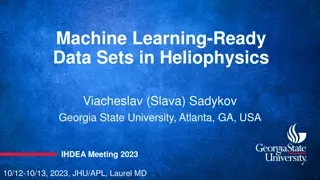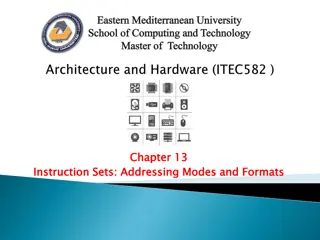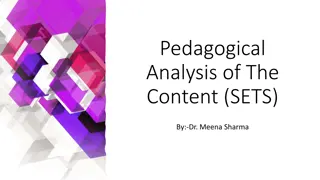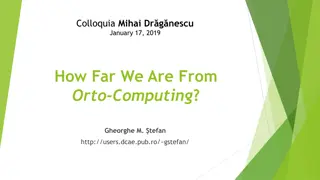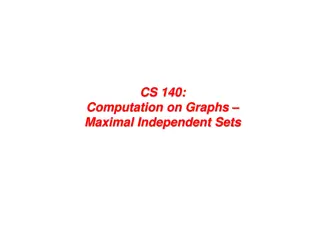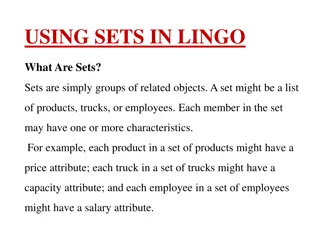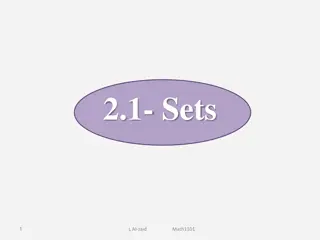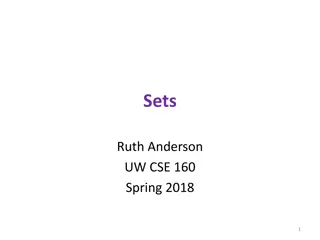Understanding Machine Instruction Sets in Computing
This material discusses the characteristics and functions of machine instruction sets in the context of computing technology. It covers essential elements of machine instructions, types of operands, and the operation of the processor. Topics include operation codes, operand references, and instruction execution processes. The content provides insights into the fundamental aspects of instruction sets and their role in computing systems.
- Machine Instruction Sets
- Computing Technology
- Operand Types
- Processor Operation
- Instruction Execution
Download Presentation

Please find below an Image/Link to download the presentation.
The content on the website is provided AS IS for your information and personal use only. It may not be sold, licensed, or shared on other websites without obtaining consent from the author. Download presentation by click this link. If you encounter any issues during the download, it is possible that the publisher has removed the file from their server.
E N D
Presentation Transcript
Eastern Mediterranean University School of Computing and Technology Master of Technology Chapter 1 Chapter 12 2 Instruction Sets: Characteristics and Functions Instruction Sets: Characteristics and Functions 1
Learning Objectives After studying this chapter, you should be able to Present an overview of essential characteristics of machine instructions. Describe the types of operands used in typical machine instruction sets. Describe the types of operands supported by typical machine instruction sets. 2
1. Machine Instruction Characteristics Elements of a Machine Instruction The operation of the processor is determined by the instructions it executes, referred to as machine instructions or computer instructions. The collection of different instructions that the processor can execute is referred to as the processor s instruction set Each instruction must contain required by the processor for execution. instruction set. must contain the information 3
What are the typical elements of a machine instruction? These elements are as follows; Operation code , Source operand reference, Result operand reference and Next instruction reference Operation code: Specifies the operation to be performed (e.g., ADD, I/O). The operation is specified by a binary code, known as the operation code, or opcode. Source operand reference: The operation may involve one or more source operands, that is, operands that are inputs for the operation. 4
Result operand reference: The operation may produce a result. Next instruction reference: This tells the processor where to fetch the next instruction after the execution of this instruction is complete. What types of locations can hold source and destination operands? Source and result operands can be in one of four areas: Main or virtual memory: As with next instruction references, the main or virtual memory address must be supplied Processor register: A processor contains one or more registers that may be referenced by machine instructions. Immediate: The value of the operand is contained in a field in the instruction being executed I/O device: The instruction must specify the I/O module and device for the operation. 5
Figure shows the steps involved in instruction execution and defines the elements of a machine instruction. Instruction Cycle State Diagram Instruction Cycle State Diagram 6
Instruction Address Calculation The address of the next instruction is computed. A permanent number is inserted to the address of the earlier instruction. Instruction Fetch The instruction is read from its specific memory location to the processor. Instruction Operation Decoding The instruction is interpreted and the type of operation to be implemented and the operand(s) to be used are decided. Operand Address Calculation The address of the operand is evaluated if it has a reference to an operand in memory or is applicable through the Input/Output. Operand Fetch The operand is read from the memory or the I/O. Data Operation The actual operation that the instruction contains is executed. Store Operands It can store the result acquired in the memory or transfer it to the I/O. 7
Within the computer, each instruction is represented by a sequence of bits. The instruction is divided into fields, corresponding to the constituent elements of the instruction. A simple example of an instruction format is shown in the figure. A simple instruction format A simple instruction format 8
In machine code each instruction has a unique bit pattern. For human consumption (programmers) a symbolic representation instructions is used. symbolic representation of machine 9
Opcodes are represented by abbreviations, called mnemonics operation. Common examples ADD - Add SUB - Subtract MUL - Multiply DIV - Divide LOAD - Load data from memory STOR - Store data to memory mnemonics, that indicate the examples include: 10
Operands are also represented symbolically. For example, the instruction ADD R,Y (R R + Y ) contained in data location Y to the contents of register R. In this example, Y refers to the address of a location in memory, and R refers to a particular register. Note that the operation is performed on the contents of a location, not on its address. ADD R,Y (R R + Y ) may mean add the value R refers to a particular register. 11
Consider a high-level language instruction that could be expressed X=X+Y. This statement instructs the computer to add the value stored in Y to the value stored in X and put the result in X. Let us assume that the variables X and Y correspond to memory locations 513 and 514. This operation could be accomplished with three instructions: 1. Load a register with the contents of memory location 513 2. Add the contents of memory location 514 to the register 3. Store the contents of the register in memory location 513 12
This is a typical relationship between a high- level language and a machine language. A high-level language expresses operations in a concise algebraic form, using variables. A machine language expresses operations in a basic form involving the movement of data to or from registers. Therefore, a computer should have a set of instructions that allows the user to formulate any data processing task. 13
Thus, the set of machine instructions must be sufficient to express any of the instructions from a high-level language. With this in mind we can categorize instruction types as follows: Data processing Data storage registers, memory locations Data movement (I/O) Program flow control categorize instruction types as follows: Data processing: : arithmetic and logic instructions Data storage (main memory) (main memory): : data in/out to/from Data movement (I/O): : I/O instructions Program flow control: : test test and branch instructions 14
Arithmetic processing numeric data. Logic These operations are performed primarily on data in processor registers. I/O into memory and the results of computations back out to the user. Test the status of a computation. Branch of instructions depending on the decision made. Arithmetic instructions provide computational capabilities for Logic (Boolean) (Boolean) instructions operate on the bits of a word. I/O instructions are needed to transfer programs and data Test instructions are used to test the value of a data word or Branch instructions instructions are then used to branch to a different set 15
One of the traditional ways of describing processor architecture is in terms of the number of addresses contained in each instruction. W What is the one might need in an instruction? A All ll arithmetic and logic operations are either unary source operands). number of addresses contained in each instruction. hat is the maximum number of addresses one might need in an instruction? arithmetic and logic operations are either unary (one source operand) or source operands). maximum number of addresses (one source operand) or binary binary (two (two 16
Thus, we would need a maximum of two addresses to reference source operands for arithmetic and logic operations. The result of an operation must be stored, suggesting a third address, which defines a destination operand. Finally, after completion of an instruction, the next instruction must be fetched, and its address is needed. If an instruction contains four addresses, what might be the purpose of each address? This line of reasoning suggests that an instruction could plausibly be required to contain four address references: two source operands, one destination operand, and the address of the next instruction. 17
In most architectures, many instructions have one, two, or three operand addresses, with the address of the next instruction being implicit (obtained from the program counter). For example, the load and store multiple instructions of the ARM architecture, designate up to 17 register operands in a single instruction Compare typical one-, two-, and three- address instructions that could be used to compute Y = (A - B)/[C + (D * E)]. 18
3 addresses Operand 1, Operand 2, Result a = b + c; With three instruction specifies two source operand locations and a destination operand This format is not common because it requires a relatively long instruction format to hold the three address references. 3 addresses format format address instrcutions, each two source operand locations and a destination operand location three- -address location. 19
Write a program to compute by using three Write a program to compute by using three address instructions. address instructions. 20
2 addresses One address doubles as operand and result a = a + b The two requirement requires some extra work.To avoid altering the value of an operand, a MOVE instruction is used move one of the values to a result or temporary location before performing the operation. 2 addresses format format two- -address requirement and the address format reduces the space the length of instruction reduces the space length of instruction but MOVE instruction is used to 21
Write a program to compute by using two address instructions. 22
Simpler yet is the one-address instruction. For this to work, a second address implicit. This was common in earlier machines, with the implied address being a processor register known accumulator contains one of the operands and is used to store the result. must be as the accumulator accumulator (AC) (AC). The 23
Write a program to compute by using one address instructions. 24
In fact, it is possible to do with zero addresses for some instructions. zero addresses Zero-address instructions are applicable to a special memory organization, called a stack stack is a last-in-first-out set of locations. stack. A The stack is in a known location and, often, at least the top two elements are in processor registers. top two elements are in processor registers. 25
Thus, zero reference the top two stack zero- -address address instructions would top two stack elements. For example, c = a + b zero addresses push a push b add pop c c = a + b can be implemented by zero addresses as: 26
Write a program to compute by using zero address instructions. PUSH A PUSH B SUB PUSH C PUSH D PUSH E MUL ADD DIV POP Y 27
Table below summarizes the interpretations to be placed on instructions with zero, one, two, or three addresses. In each case in the table, it is assumed that the address of the next instruction is implicit, and that one operation with two source operands and one result operand is to be performed 28
More addresses per instruction results; More complex instructions Fewer instructions per program More registers Fewer addresses per instruction results; Less complex instructions More instructions per program Faster fetch/execution of instructions For reasons of flexibility and ability to use multiple registers, most contemporary machines employ a mixture of two- and three-address instructions. 29
The design of an instruction set is very complex because it affects so many aspects of the computer system. The instruction set defines many of the functions performed by the processor thus implementation of the processor. The instruction set is the programmer s means of controlling the processor. processor and effect has a significant on the 30
Instruction set design issues includes: Operation repertoire How many operations ? What can they do? How complex are they? Data types Instruction formats Length of op code field Number of addresses Registers Number of CPU registers available and which operations can be performed on which registers? Addressing modes by which the address of an operand is specified. 31
What types of operands are typical in machine instruction sets? The most important general categories of data are: Addresses (In many cases, some calculation must be performed on the operand reference in an instruction to determine the main or virtual memory address.) Numbers (Integer/floating point) Characters (ASCII etc.) Logical Data (Bits or flags) 32
General 8 bit - byte 16 bit - word 32 bit - doubleword 64 bit - quadword 128 bit - double quadword Integer A signed binary value contained in a byte, word, or doubleword, using twos complement representation. Ordinal An unsigned integer contained in a byte, word, or doubleword. Floating point 33
ARM processors support data types of 8 bits byte 16 bits halfword 32 bits - word Majority of implementations do not provide floating-point hardware Saves power and area Floating-point arithmetic implemented in software ARM supports optional floating-point coprocessor that supports single- and double-precision floating point data types defined in IEEE 754 34
The number of different opcodes varies widely from machine to machine. However, the same general types of operations are found on all machines. A useful and typical categorization is the following: Data Transfer Arithmetic Logical Conversion I/O System Control Transfer of Control 35
Transfer data from one location to another. The data transfer instruction must specify the location of the source and destination operands. Each location could be memory, a register, or the top of the stack. If memory is involved: Determine memory address Perform virtual-to-actual-memory address transformation Check cache Initiate memory read/write 36
Data Transfer The data transfer instruction must specify several things Data Transfer The location of the source and destination operands must be specified. Each location could be memory, a register, or the top of the stack. The length of data to be transferred must be indicated. All instructions with operands, the mode of addressing for each operand must be specified. 40
In terms of processor action, data transfer operations are perhaps the simplest type. If both source and destination are registers, then the processor simply causes data to be transferred from one register to another; this is an operation internal to the processor. If one or both operands are in memory, then the processor must perform some or all of the following actions: 1. Calculate the memory address, based on the address mode. 2. If the address refers to virtual memory, translate from virtual to real memory address. 3. Determine whether the addressed item is in cache. 4. If not, issue a command to the memory module. 41
May involve data transfer, before and/or after. Perform function in ALU Add, Subtract, Multiply, Divide May include Increment (a++) Decrement (a--) Absolute (|a|) Negate (-a) Set flags 42
Bitwise operations AND, OR, NOT, XOR, EQUALS 43
Most machines provide a variety of shift and rotate and rotate functions 44
With a logical shift, the bits of a word are shifted left or right. On one end, the bit shifted out is lost. On the other end, a 0 is shifted in. A right arithmetic shift corresponds to a division by 2, with truncation for odd numbers. An arithmetic left shift corresponds to a multiplication by 2 Rotate, or cyclic shift, operations preserve all of the bits being operated on. One use of a rotate is to bring each bit successively into the leftmost bit, where it can be identified by testing the sign of the data 45
Conversion instructions are those that change the format or operate on the format of data. An example is converting from decimal to binary. May involve special logic to perform conversion. 46
Issue command to I/O module There are a variety of approaches including programmed I/O, interrupt driven I/O, DMA, and the use of an I/O processor. Many implementations provide only a few I/O instructions, with the specific actions specified by parameters, codes, or command words. 48
System control instructions are those that can be executed only while the processor is in a certain privileged state or is executing a program in a special privileged area of memory. Typically, these instructions are reserved for the use of the operating system. For example, a system control instruction may read or alter a control register. 49
A significant fraction of the instructions in any program have as their function changing the sequence of instruction execution. For these instructions, the operation performed by the processor is to counter instruction to update the address update the address of the program of some program some counter to instruction in to contain in memory contain the memory. . The most common transfer of control operations found in instruction sets are branch, skip and procedure call. 50



